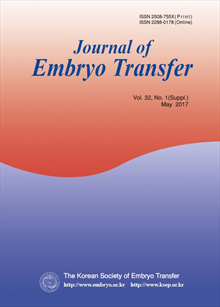간행물
한국동물생명공학회 학술대회논문집

- 발행기관 한국동물생명공학회(구 한국수정란이식학회)
- 자료유형 학술대회
- 간기 반년간
- 수록기간 1997 ~ 2018
- 주제분류 자연과학 > 생물공학 자연과학 분류의 다른 간행물
- 십진분류KDC 527DDC 636
권호리스트/논문검색
2000년도 춘계심포지움 (2000년 5월) 6건
1.
2000.05
구독 인증기관 무료, 개인회원 유료
4,000원
2.
2000.05
구독 인증기관 무료, 개인회원 유료
5,200원
3.
2000.05
구독 인증기관 무료, 개인회원 유료
4,000원
4.
2000.05
구독 인증기관 무료, 개인회원 유료
4,200원
5.
2000.05
구독 인증기관 무료, 개인회원 유료
4,800원
6.
2000.05
구독 인증기관 무료, 개인회원 유료
During the last three decades considerable advances has been made in goat embryo production and transfer technology. The Korean native black goat is the most useful domestic ruminant in this country for biological investigation and application because it has a lot of merits such as relatively short generation period (1 vs 2 year for a cow), easy of handling, well adaptation, high fertility, convenient and inexpensive. This article covers the methods of superovulation, estrus synchronization, embryo collection and transfer techniques, pregnancy diagnosis and subsequent pregnancy and kidding rates for the production of transgenic Korean native black goats. More than one hundred goat kids have been produced as a result of our transgenic goat project via microinjection of foreign gene into pronuclei, in vitro culture, transfer of various stages of fresh and frozen-thawed microinjected embryos into oviducts or uteri of recipient does. We have got two transgenic goats carrying a transgene targeting the expression of recombinant human granulocyte colony stimulating factor (hG-CSF) to the mammary gland so far. Since collection and transfer of embryos in this species is usually accomplished by laparotomy, exteriorization of the reproductive tract for surgical embryo collection leads to the formation of post-operative adhesions. Nonsurgical or laparoscopic technique to reduce adhesions from repeated surgeries has great advantages in improving embryo production and transfer especially from valuable donors. We will discuss this later.
4,300원

